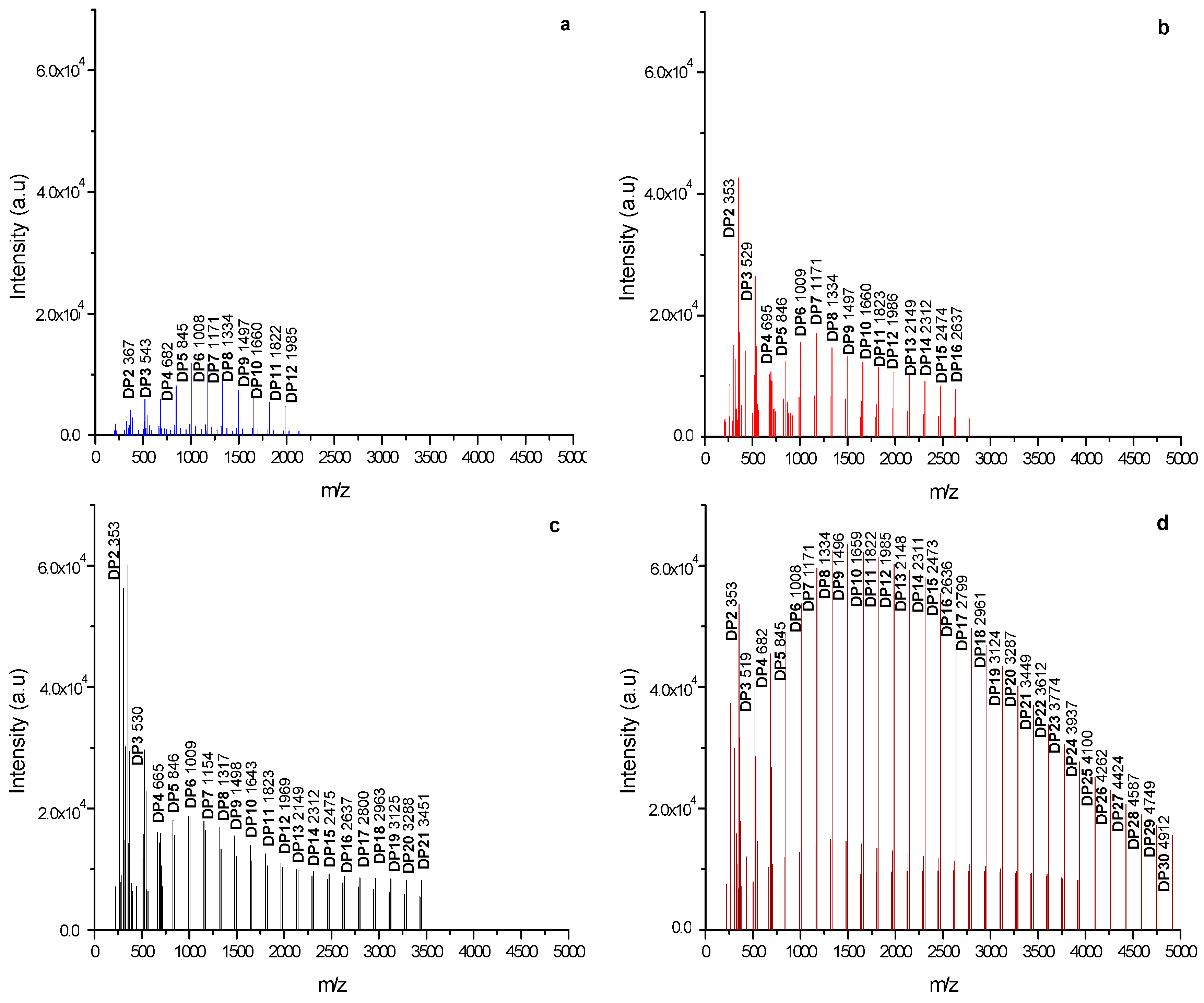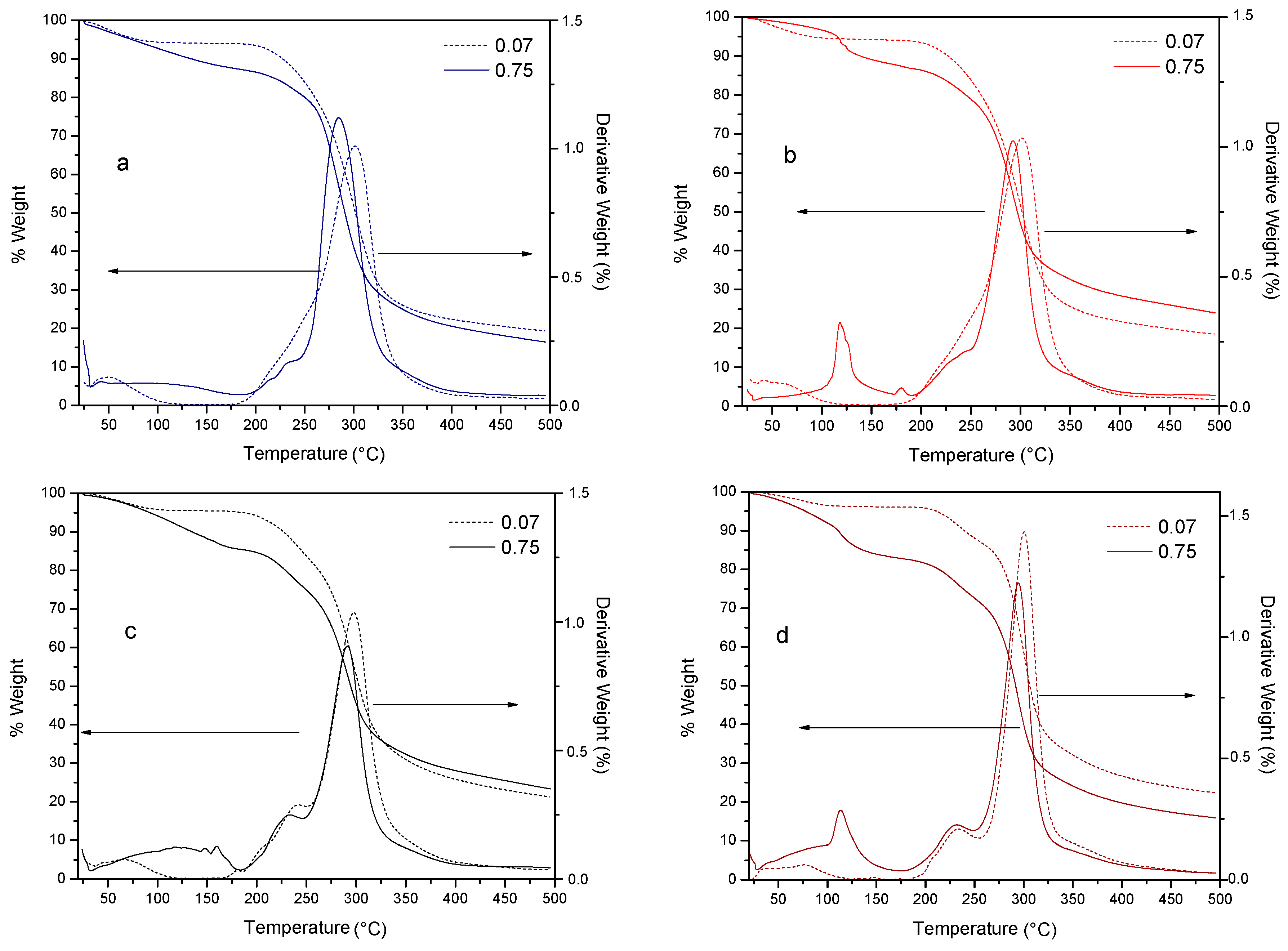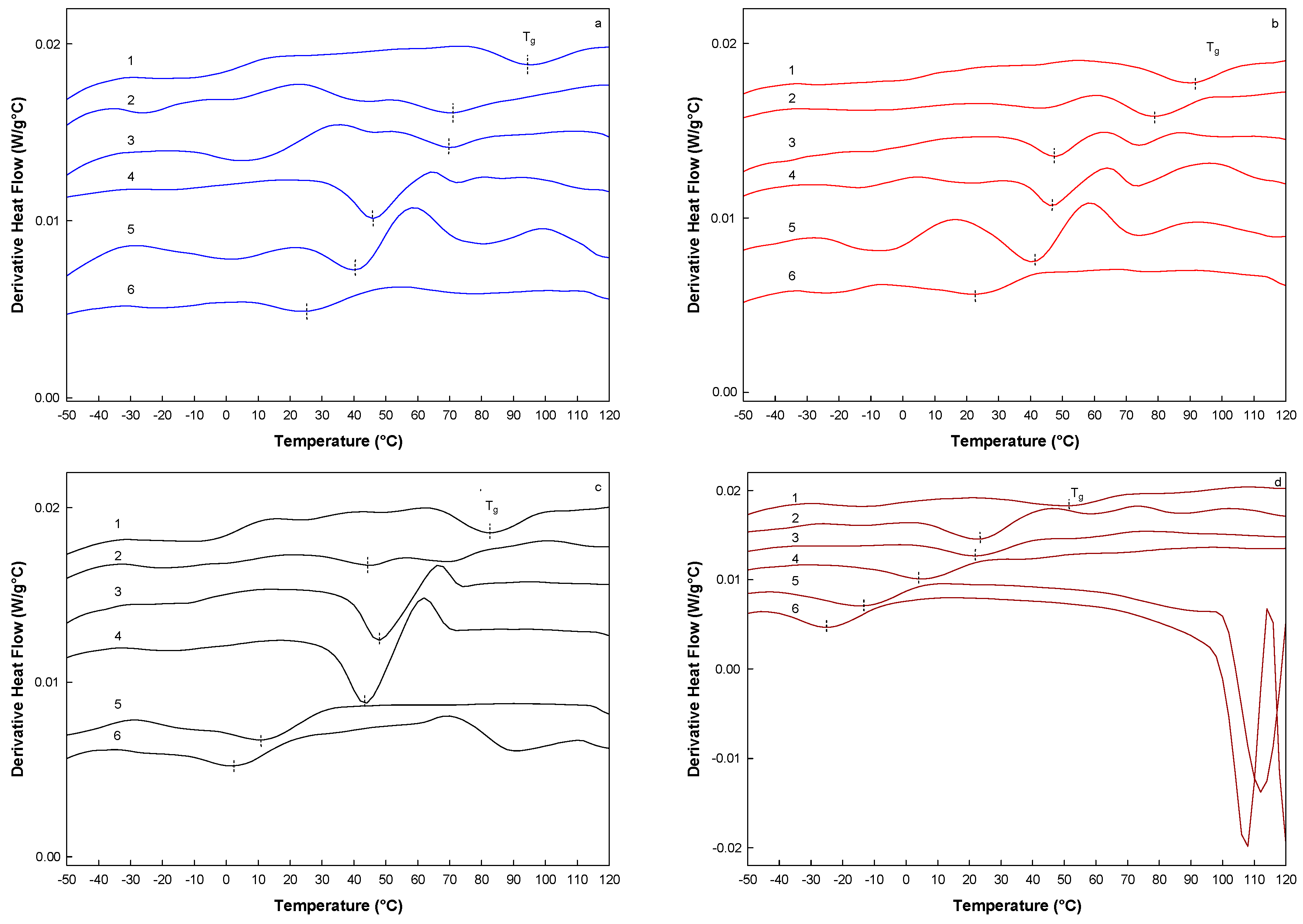Technological Application of Maltodextrins According to the Degree of Polymerization
Abstract
:1. Introduction
2. Results and Discussion
2.1. Determination of the Degree of Polymerization of Powdered Maltodextrins

| Maltodextrin | DE 1 (%) | DE 2 (%) | MALDI-TOF | |||
|---|---|---|---|---|---|---|
| Mw (g/mole) | Mn (g/mole) | Xn | DP (Units of Glucose) | |||
| Mc | ------ | 7 ± 1.02 | 1335 ± 106 | 1168 ± 93 | 1.14 | 2–12 |
| M10 | 9–14 | 10 ± 1.98 | 1625 ± 113 | 1205 ± 84 | 1.34 | 2–16 |
| M20 | 18–22 | 21 ± 2.04 | 1925 ± 96 | 1324 ± 66 | 1.45 | 2–21 |
| M40 | 37–42 | 39 ± 1.27 | 2873 ± 172 | 2242 ± 134 | 1.28 | 2–30 |
2.2. Sorption Isotherms

| Maltodextrin | GAB Model Parameters | |||
|---|---|---|---|---|
| c | k | m0 | r2 | |
| Mc | 6.26634 | 0.10599 | 23.29 | 0.997 |
| M10 | 8.647117 | 0.698417 | 5.25 | 0.996 |
| M20 | 1.098873 | 0.31986 | 41.33 | 0.992 |
| M40 | 11.58617 | 0.94973 | 4.12 | 0.993 |
2.3. Simultaneous Thermal Analysis (TGA-DSC)

| Maltodextrin | aw | Td onset (°C) | Td peak (°C) |
|---|---|---|---|
| Mc | 0.07 | 180.1 | 301.4 |
| 0.75 | 190.1 | 284.7 | |
| M10 | 0.07 | 165.2 | 301.7 |
| 0.75 | 192.8 | 292.4 | |
| M20 | 0.07 | 163.4 | 297.6 |
| 0.75 | 182.1 | 291.2 | |
| M40 | 0.07 | 180.9 | 300.4 |
| 0.75 | 181.8 | 294.6 |
2.4. Modulated Differential Scanning Calorimetry (MDSC)

2.5. Microstructural Analysis


3. Experimental Section
3.1. Sample Preparation
3.2. Mass Spectrometry Analysis
3.3. Sorption Isotherms
3.4. Thermal Analysis
3.5. Modulated Differential Scanning Calorimetry (MDSC)
3.6. Structural Analysis by X-Ray Diffraction (XRD)
3.7. Optical Microscopy
4. Conclusions
Acknowledgments
Author Contributions
Conflicts of Interest
References
- Valenzuela, C.; Aguilera, J.M. Effects of maltodextrin on hygroscopicity and crispness of apple leathers. J. Food Eng. 2015, 144, 1–9. [Google Scholar] [CrossRef]
- Sun, J.; Zhao, R.; Zeng, J.; Li, G.; Li, X. Characterization of Destrins with Different Dextrose Equivalents. Molecules 2010, 15, 5162–5173. [Google Scholar] [CrossRef] [PubMed]
- Udomrati, S.; Gohtani, S. Tapioca maltodextrin fatty acid ester as a potential stabilizer for Tween 80-stabilized oil-in-water emulsions. Food Hydrocoll. 2015, 44, 23–31. [Google Scholar] [CrossRef]
- Rong, Y.; Sillick, M.; Gregson, C.M. Determination of Dextrose Equivalent Value and Number Average Molecular Weight of Maltodextrin by Osmometry. J. Food Sci. 2009, 74, C33–C40. [Google Scholar] [CrossRef] [PubMed]
- Descamps, N.; Palzer, S.; Roos, Y.H.; Fitzpatrick, J.J. Glass transition and flowability/caking behaviour of maltodextrin DE 21. J. Food Eng. 2013, 119, 809–813. [Google Scholar] [CrossRef]
- Santiago, A.R.; Medina, T.L.; Gallegos, I.J.A.; Calderas, F.; González, L.R.F.; Rocha, G.N.E.; Ochoa, M.L.A.; Bernard, B.M.J. Spray drying-microencapsulation of cinnamon infusions (Cinnamomum zeylanicum) with maltodextrin. LWT Food Sci. Technol. 2015, 64, 571–577. [Google Scholar] [CrossRef]
- Kao, T.H.; Chen, B.H. Effects of different carriers on the production of isoflavone powder from soybean cake. Molecules 2007, 12, 917–931. [Google Scholar] [CrossRef] [PubMed]
- Porras, S.J.; Palacios, G.E.; Lartundo, R.L.; Garibay, F.V.; Yáñez, F.J.; Hernández, S.H.; Gutiérrez, L.G.; Alamilla, B.L. Microstructural properties and distribution of components in microparticles obtained by spray-drying. J. Food Eng. 2015, 152, 105–112. [Google Scholar] [CrossRef]
- Solval, K.M.; Sundararajan, S.; Alfaro, L.; Sathivel, S. Development of cantaloupe (Cucumis melo) juice powders using spray drying technology. LWT Food Sci. Technol. 2012, 46, 287–293. [Google Scholar] [CrossRef]
- Paini, M.; Aliakbarian, B.; Casazza, A.A.; Lagazzo, A.; Botter, R.; Perego, P. Microencapsulation of phenolic compounds from olive pomace using spray drying: A study of operative parameters. LWT Food Sci. Technol. 2015, 62, 177–186. [Google Scholar] [CrossRef]
- Castro, M.R.; Barragán, H.B.E.; Yáñez, F.J. Use of gelatin-maltodextrin composite as an encapsulation support for clarified juice from purple cactus pear (Opuntia stricta). LWT Food Sci. Technol. 2015, 62, 242–248. [Google Scholar] [CrossRef]
- Saavedra, L.M.Z.; Leyva, P.C.; Martínez, G.E.; Pérez, G.S.A.; Aguilar, M.J.A.; Álvarez, S.C. Physical properties of inulin and inulin-orange juice: Physical characterization and technological application. Carbohydr. Polym. 2014, 105, 10–19. [Google Scholar] [CrossRef] [PubMed]
- Bhusari, S.N.; Muzaffar, K.; Kumar, P. Effect of carrier agents on physical and microstructural properties of spray dried tamarind pulp powder. Powder Technol. 2014, 266, 354–364. [Google Scholar] [CrossRef]
- Harvey, D.J. Analysis of carbohydrates and glycoconjugates by matrix-assisted laser desorption/ionization mass spectrometry: An update for the period 2005–2006. Mass Spectrom. Rev. 2011, 30, 1–100. [Google Scholar] [CrossRef] [PubMed]
- Kazmaier, T.; Roth, S.; Zapp, J.; Harding, M.; Kuhn, R. Quantitative analysis of malto-oligosaccharides by MALDI-TOF mass spectrometry, capillary electrophoresis and anion exchange chromatography. J. Anal. Chem. 1998, 361, 473–478. [Google Scholar] [CrossRef]
- Zhu, H.; Yalcin, T.; Li, L. Analysis of the Accuracy of Determining Polydispersity Polymers by Matrix-Assisted. Am. Soc. Mass Spectrom. 1998, 9, 275–281. [Google Scholar] [CrossRef]
- De Meuter, P.; Rahier, H.; van Mele, B. Recrystallisation of starch studied with MDSC. Nat. Biol. Syst. Reveal. Therm. Methods 2004, 2, 49–68. [Google Scholar]
- Kennedy, J.F.; Noy, R.J.; Stead, J.A.; White, C.A. Factors Affecting, and Prediction of, the Low Temperature Precipitation of Commercial Low DE Maltodextrins. Starch 1986, 38, 273–281. [Google Scholar] [CrossRef]
- Chronakis, I.S. On the molecular characteristics, compositional properties, and structural-functional mechanisms of maltodextrins: A review. Crit. Rev. Food Sci. Nutr. 1998, 38, 599–637. [Google Scholar] [CrossRef] [PubMed]
- Marchal, L.M.; Beeftink, H.H.; Tramper, J. Towards a rational design of commercial maltodextrins. Trends Food Sci. Technol. 1999, 10, 345–355. [Google Scholar] [CrossRef]
- Silva, M.D.; Nunes, C.; Pereira, I.; Moreira, A.S.P.; Domingues, M.M.R.; Coimbra, A.M.; Gama, M.F. Structural analysis of dextrins and characterization of dextrin-based biomedical hidrogels. Carbohydr. Polym. 2014, 114, 458–466. [Google Scholar] [CrossRef] [PubMed]
- Timmmermann, E.O. A BET-like three sorption stage isotherm. Journal of Chemical Society. J. Chem. Soc. 1989, 85, 1631–1645. [Google Scholar]
- Brunauer, S.; Deming, L.S.; Deming, W.E.; Teller, E. On a theory of Van der Waals adsorption of gases. J. Am. Chem. Soc. 1940, 62, 23–1732. [Google Scholar] [CrossRef]
- Fabra, M.J.; Talens, P.; Moraga, G.; Martínez, N.N. Sorption isotherm and state diagram of grapefruit as a tool to improve product processing and stability. J. Food Eng. 2009, 93, 52–58. [Google Scholar] [CrossRef]
- Mosquera, L.H.; Moraga, G.; Martínez, N.N. Critical water activity and critical water content of freeze-dried strawberry powder as affected by maltodextrin and arabic gum. Food Res. Int. 2012, 47, 201–206. [Google Scholar] [CrossRef]
- Prieto, F.; Gordillo, A.; Prieto, J.; Aldapa, C.; Román, A. Evaluación de las isotermas de sorción en cereales para desayuno. Superf. Vacío 2006, 19, 12–19. [Google Scholar]
- Lewicki, P.P. The applicability of the GAB model to food water sorption isotherms. Int. J. Food Sci. Technol. 1997, 32, 553–557. [Google Scholar] [CrossRef]
- Pérez, A.C.; Beristain, C.I.; Lobato, C.C.; Rodríguez, H.M.E.; Vernon, C.E.J. Thermodynamic analysis of the sorption isotherms of pure and blended carbohydrate polymers. J. Food Eng. 2006, 77, 753–760. [Google Scholar] [CrossRef]
- Martínez, N.N.; Andrés, G.A.M.; Boix, C.; Fito, M.P. Termodinámica Y Cinética de Sistemas Alimento Entorno; Universitat Politècnica de València: Valencia, Spain, 1998; pp. 8–66. [Google Scholar]
- Jiang, B.; Liu, Y.T.; Bhandari, B.; Zhou, W.B. Impact of caramelization on the glass transition temperature of several caramelized sugars. Part 1: Chemical analyses. J. Agric. Food Chem. 2008, 56, 5148–5152. [Google Scholar] [CrossRef] [PubMed]
- Rahman, M.S. Food stability determination by macro-micro region concept in the state diagram and by defining a critical temperature. J. Food Eng. 2010, 99, 402–416. [Google Scholar] [CrossRef]
- Kumar, L.; Popat, D.; Bansal, A.K. Investigation of the Atypical Glass Transition and Recrystallization Behavior of Amorphous Prazosin Salts. Pharmaceutics 2011, 3, 525–537. [Google Scholar] [CrossRef] [PubMed]
- Collares, F.P.; Kieckbusch, T.G.; Finzer, J.R.D. Revisão : A Transição Vítrea em Produtos Alimentícios Review : Glass Transition in Food Products. Braz. J. Food Technol. 2002, 5, 117–130. [Google Scholar]
- Peng, Z.; Li, J.; Guan, Y.; Zhao, G. Effect of carriers on physicochemical properties, antioxidant activities and biological components of spray-dried purple sweet potato flours. LWT Food Sci. Technol. 2013, 51, 348–355. [Google Scholar] [CrossRef]
- Busin, L.; Buisson, P.; Bimbenet, J.J. Notion de transition vitreuse appliqué au sechage par pulverisation de solutions glucidiques. Sci. Aliment. 1996, 16, 443–459. [Google Scholar]
- Wang, Y.J.; Wang, L. Structures and Properties of Commercial Maltodextrins from Corn, Potato, and Rice Starches. Starch 2000, 52, 296–304. [Google Scholar] [CrossRef]
- Lane, J.H.; Eynon, L. Volumetric determination of reducing sugars by means of Fehling’s solution, with methylene as internal indicator. J. Chem. Soc. Trans. 1923, 42, 32–36. [Google Scholar]
- Kiranoudis, C.T.; Maroulis, Z.B.; Tsami, E.; Marinos, K.D. Equilibrium moisture content and heat of desorption of some vegetables. J. Food Eng. 1993, 20, 55–74. [Google Scholar] [CrossRef]
- Sample Availability: Samples are available from the authors.
© 2015 by the authors. Licensee MDPI, Basel, Switzerland. This article is an open access article distributed under the terms and conditions of the Creative Commons by Attribution (CC-BY) license ( http://creativecommons.org/licenses/by/4.0/).
Share and Cite
Saavedra-Leos, Z.; Leyva-Porras, C.; Araujo-Díaz, S.B.; Toxqui-Terán, A.; Borrás-Enríquez, A.J. Technological Application of Maltodextrins According to the Degree of Polymerization. Molecules 2015, 20, 21067-21081. https://doi.org/10.3390/molecules201219746
Saavedra-Leos Z, Leyva-Porras C, Araujo-Díaz SB, Toxqui-Terán A, Borrás-Enríquez AJ. Technological Application of Maltodextrins According to the Degree of Polymerization. Molecules. 2015; 20(12):21067-21081. https://doi.org/10.3390/molecules201219746
Chicago/Turabian StyleSaavedra-Leos, Zenaida, César Leyva-Porras, Sandra B. Araujo-Díaz, Alberto Toxqui-Terán, and Anahí J. Borrás-Enríquez. 2015. "Technological Application of Maltodextrins According to the Degree of Polymerization" Molecules 20, no. 12: 21067-21081. https://doi.org/10.3390/molecules201219746








